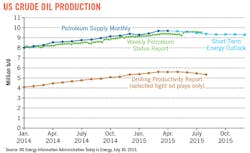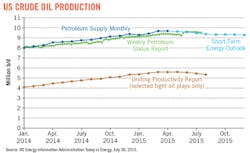Independent producers face a dilemma when it comes to light, tight oil production because each new well means more output to sell, but those barrels also add to a growing US oil inventory, which puts downward pressure on commodity prices.
In reporting second-quarter earnings, unconventional operators including Anadarko, Hess, and Continental Resources Inc. raised their 2015 production guidance. They noted lower service costs and improved drilling efficiencies mean companies spend less to produce more than they did years ago.
The better-than-expected production reports accompanied writedowns for several companies.
Chevron Corp. Chief Executive Officer John Watson said, "Our upstream businesses were particularly hard hit as lower [oil] prices reduced revenues and triggered impairments and other charges." Chevron reported a noncash impairment of about $2 billion. It did not specify impairment charges by play.
James Volker, Whiting Petroleum Corp. chief executive officer, said he would be willing to start running more rigs again if US light, sweet crude oil prices reach $60/bbl for 4 months.
Separately, Anadarko reported it can drill a horizontal well at its Wattenberg acreage in Colorado for about $1 million, less than half of its first-quarter cost for a Wattenberg well.
"It's not just price reductions from various service vendors that in a different hydrocarbon price environment would come back to us as a higher price," said Al Walker, Anadarko chief executive officer. "These are sustainable improvements."
During an earnings call, he said Anadarko is "drilling the same number of wells with half the rigs" within the last year. Walker said Anadarko had no plans to "increase our capital plans beyond initial guidance through the balance of the year."
Anadarko set its 2015 capital expenditure guidance at $5.4-$5.8 billion. The company now is targeting US oil output of 221,000-225,000 b/d for the year, up from a first-quarter guidance of 207,000-211,000 b/d.
Hess raises Bakken guidance
Hess raised its 2015 production guidance to 360,000-370,000 boe/d, largely driven by the Bakken formation in North Dakota where executives anticipate 105,000-110,000 boe/d in production, up from an earlier target of 95,000-105,000 boe/d.
Chief Executive Officer John Hess said Hess plans to leverage its "lean manufacturing" techniques from the Bakken to its joint venture acreage with Consol Energy Inc. in the Utica.
Separately, Continental Resources of Oklahoma City announced plans to reduce its operated rig count in the Bakken by 2 rigs so that the company would run 8 rigs there by Sept. 30.
Continental announced plans on Sept. 8 to spend $300-350 million less than its previously approved 2015 capital budget given the continuing oil price slump.
Executives planned to defer well completion activity except for where the company has contractual considerations or specific strategic objectives.
"While we do not believe today's low commodity prices are sustainable long term, we are committed to living within cash flow until they recover," said Harold Hamm, Continental chairman and chief executive officer. "We are reducing capital expenditures to protect our balance sheet and to preserve the value of our world-class assets until commodity prices improve."
Hamm said the company's 2015 guidance remained the same. Continental still expects production growth of 19-23% for 2015 compared with 2014.
Executives anticipated ending 2015 with 200,000-215,000 boe/d production companywide. The bottom end of the range was 10,000 boe/d below its previous outlook. Executives said they anticipated an inventory of 160 gross drilled but not completed wells by Dec. 31.
Previously, Continental noted actual capital spending was trending below its budget. John Hart, chief financial officer, said Continental deferred new production growth until commodity prices rebound.
"We can achieve this objective due to our focus on costs, operating efficiencies, and having a large portion of our high-potential leasehold already held by production," Hart said. "Obviously we are in a dynamic environment, and our outlook could change. We will continue reviewing our spending plans."
Continental continued to have ample liquidity with $1.3 billion available as of Aug. 31, he said.
Encana concentrates its budget on Texas, Canada shale plays
Encana's net loss for the second quarter was $1.6 billion, mostly due to an impairment charge. Without that and other unusual costs and charges, Encana's operating loss was $167 million compared with a net profit of $271 million for the same period last year.
The Calgary company is spending more than 80% of its budget on oil in the Permian and Eagle Ford basins in Texas and on gas in Canada's Duvernay and Montney.
Doug Suttles, Encana's president and chief executive officer, said it's hard to predict how long oil prices might continue to stay at $50/bbl or lower.
"We have to let the market rebalance," Suttles said. "There's been quite a bit of speculation about when and how that will occur, but it's clearly trying to find its feet."
Global oil demand has grown more than expected, but that demand growth was offset by higher production from members of the Organization of Petroleum Exporting Countries, especially Saudi Arabia.
"The real question is does it work itself out over 6 months or does it take a couple of years," Suttles said. "I don't know the answer to that. We're well prepared to manage through that."
Suttles said he foresees asset transactions picking up during the second half for the oil and gas industry in general. Encana reduced spending plans in February, and Suttles said potential buyers have asked Encana about whether any assets might be for sale.
"The longer you're in a lower price, the more likely the buyer and the seller can get closer to what they expect to receive, and I think that's happening," he said.
Another Permian operator, Pioneer Natural Resources Co., planned to bring an average of 2 horizontal rigs/month onstream in the northern Spraberry-Wolfcamp during the second half.
PNR intends to add 8 horizontal units during first-quarter 2016, of which 6 are expected to be added in the northern Spraberry-Wolfcamp and 2 in the Eagle Ford.
Noble Energy keen on Delaware basin
Noble Energy is producing more oil and gas this year than last year despite falling oil and gas prices even while it posted a $109 million second-quarter loss.
David Stover, Noble Energy chairman, president, and chief executive officer, said strong assets and balance sheet protected the company during the oil price downturn.
Noble Energy acquired Rosetta Resources this year for $2.1 billion, and that deal provided Noble Energy with additional acreage in the Eagle Ford and West Texas Delaware basin.
"It was the right opportunity at the right time for Noble Energy," Stover said, adding the integration of these assets is on track. "We've hit the ground running, and we're already seeing more value potential than we originally assumed."
Stover believes Noble Energy is in a good position to grow while other companies are cutting back.
"We have the financial strength to navigate through a volatile market and take advantage of opportunities," Stover said. "All oil and natural gas companies are facing choppy seas right now, but I believe investors are very well-positioned with Noble Energy."
Total lease operating costs, which include the cost of labor for operating leased equipment, have fallen to levels not seen in 5 years or more, Stover said.
"Mid-year 2015 marks a strategic inflection point for Noble Energy," Stover said. "Looking forward, our production is ramping through the remainder of the year, while capital continues to trend lower each quarter. Production increases are driven from our onshore assets and major project startups in the Gulf of Mexico."
Devon Energy Corp. of Oklahoma City, reported a second-quarter net loss of $2.8 billion due to a noncash, full-cost ceiling charge. But executives noted US operations averaged a record 172,000 b/d oil production, which was 35% higher than the 2014 second quarter.
The company's US production surpassed Devon's earlier guidance expectations by 2,000 b/d.


